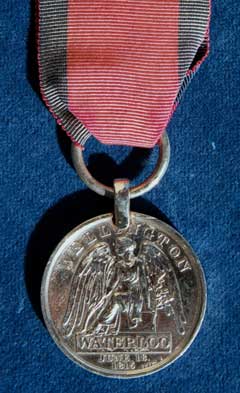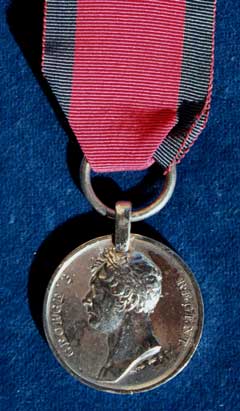MEDAL INFORMATION
Waterloo Medal (18 June 1815)
Face
The head of the Prince
Regent with the legend ‘GEORGE P. REGENT’
Reverse
The winged figure of
Victory seated on a pedestal and holding a palm branch in her right hand
and an olive branch in left. Beneath the pedestal is a rectangular base
bearing the word “WATERLOO” and beneath this, in two lines, the date “June
18 1815”. Above the figure of Victory is the word “WELLINGTON”.
Size
Approx. 36 mm diameter
Composition
The disc of the medal
is silver. The original suspension is steel.
Ribbon
Approx. 38 mm wide,
crimson with dark blue edges each approx. 7 mm wide.
Suspension
Originally issued with
a steel ring approx. 28 mm diameter which passes through a hole in a steel
clip approx. 2 mm wide that grips the rim of the disc. On many medals
this suspension has been replaced either in whole or in part by suspension
of a different pattern.
Naming
Always in large
impressed Roman capitals, with the spaces at either end filled in with
decorative stars.
Bars
None
Awarded
This was the first
medal to be awarded by the British Government to all ranks present at an
action, the Waterloo Medal was awarded to all who took part in the battles
of Ligny (16th June); Quatre Bras (16th June); and Waterloo (18th June).
In addition, every British soldier present at any of these battles was
credited with two years extra service, which counted for all purposes, and
was a ‘Waterloo Man’. It was at Waterloo that the French Army under
Napoleon Bonaparte was finally defeated by the British Army under the Duke
of Wellington and the Prussians under Marshall Gebhard von Blücher.
The King’s Own
After three years of
arduous active service in Portugal, Spain and France the 1st Battalion,
then camped near Bordeaux, was selected to form part of a force of “the
best and most experienced regiments” to sail for North America under the
Duke of Wellington’s command. The King’s Own along with the 44th and 85th
Regiments were the first detachment to sail, on 2 June 1814. Actions were
fought at Bladensburg, leading to the capture of Washington, and at Godley
Wood - both ended in victory. An attempt to capture New Orleans towards
the end of the year saw the Americans triumph. The King’s Own alone
suffered over 350 casualties in the battle. Following the peace agreement
of February 1815 the Battalion returned to England arriving at Deal on 18
May only to learn of Napoleon’s escape from Elba. The Battalion was
re-equipped and brought up to strength with men from the 2nd Battalion and
landed at Ostend on 12 June where it received orders to join Wellington’s
Army near Brussels. Marching immediately to Ghent it joined the 10th
Brigade under Sir John Lambert (4th, 27th, 40th and 81st Regiments).
Having been initially out manoeuvred by Napoleon, Wellington and Blücher
sought to concentrate their forces and Lambert’s Brigade (less the 81st)
was ordered to march towards Brussels. By marching forty-eight miles in
thirty hours The King’s Own reached the field of battle at 8.30am on 18th
June with Band playing and Colours flying - the first Regiment recently
returned from America to arrive. The Battalion was brought up from the
reserve in the afternoon when it came into the line opposite the gravel
pit near the farm - La Haye Sainte. Out of a strength of 669 all ranks
its casualties totalled 134 killed and wounded.
Waterloo Medals in the museum's collection


The Waterloo Medal



